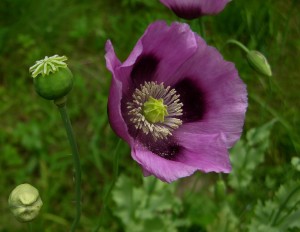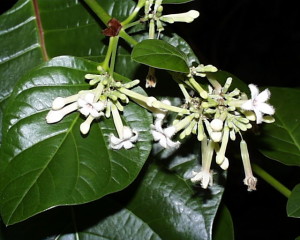Facts About Daffodils
Daffodils do more than produce pretty flowers. They also help save lives. More and more, the world is turning to medicinal plants to cure illness and disease. Who discovered these natural cures and how do they work? We focuses on 5 species.
1. SLEEPING ROSE
NAME? Papaver (Papaver somniferum) grows in countries like Afghanistan and Pakistan. It has purple and white flowers and is related to the Poppy.
WHAT IS THE ACTIVE INGREDIENT? Papaver has various medicinal uses. The best-known is in the manufacture of morphine and codeine.
The name morphine is derived from Morpheus, the Greek god of dreams. Morphine is primarily used as a painkiller, but also works as a narcotic. Codeine also works against pain and can remedy diarrhoea and a dry cough.
 USES? Papaver is used to combat pain and restlessness.
USES? Papaver is used to combat pain and restlessness.
HOW DOES IT WORK? Morphine imitates endorphins, substances in our nervous system that are responsible for sleepiness and euphoria. Endorphins produced during sport such as running can give you a ‘high’. Painkillers work in the same way. Morphine is also used to make heroin. It is very addictive and its use in medicine is limited.
WHO DISCOVERED IT? China was famous for its opium during the colonial days. By then, the Chinese were already using the plant as a painkiller and stimulant.
2. BITTER BARK
 NAME? Cinchona. This plant is found in South America where there are about 40 different species. It is found in all tropical areas and has medicinal properties. Cinchona was so popular in the 19th century that it nearly became extinct.
NAME? Cinchona. This plant is found in South America where there are about 40 different species. It is found in all tropical areas and has medicinal properties. Cinchona was so popular in the 19th century that it nearly became extinct.
WHAT IS THE ACTIVE INGREDIENT? The remedy can be found in quinine, which comes from the bark of the tree. This is also used as a bitter substance in tonic or bitter lemon.
USES? Cinchona is used to treat malaria. According to the World Health Organisation (WHO), at least 200 million people suffer from malaria and least 700,000 will die from the disease every year. The disease is spread by mosquitoes. A parasite enters the blood through the sting of the insect and this causes severe fever.
HOW DOES IT WORK? Quinine does not help against the malaria-carrying mosquito but rather against the parasite. It prevents multiplication of the parasite. However, the parasite has become resistant to quinine and scientists are now looking for new medicine.
WHO DISCOVERED IT? Natives in South America traditionally used the Cinchona bark to fight fever. Missionaries in the 17th century discovered that it also helped against the tropical malaria fever. The tree was spread around the world by colonists.
3. CANCER KILLER
 NAME? Taxus (Taxus baccata or Taxus brevifolia). The taxus grows in the north-western regions of the United States. It , is not recommended to put this conifer in your garden if you have children, as the plant is extremely poisonous. The taxus knows how to arm itself against animals. A horse that eats from the tree could be dead in as little as five minutes.
NAME? Taxus (Taxus baccata or Taxus brevifolia). The taxus grows in the north-western regions of the United States. It , is not recommended to put this conifer in your garden if you have children, as the plant is extremely poisonous. The taxus knows how to arm itself against animals. A horse that eats from the tree could be dead in as little as five minutes.
WHAT IS THE ACTIVE INGREDIENT? Taxus trees produce taxol, a substance that has never been replicated in a lab. Producing taxol is a drawn-out process. Taxol was first derived from the bark of 100-year-old trees in North America (Taxus brevifolia). Six trees were needed for the treatment of one patient. This was disastrous for the ecosystem.
USES? Cancer, particularly breast and ovarian cancer.
HOW DOES IT WORK? Cancer cells divide uninterrupted at rapid speed. Microtubule is formed during cell division.
These are like threads that pull the chromosomes apart. Taxol freezes these chromosomes and by doing so prohibits cell division. However, the substance, which is used in certain chemotherapy treatments, works on all cells, including healthy ones. This is why people undergoing chemotherapy suffer from a variety of side effects. Taxol can slow down cancer or even cure the patient completely.
WHO DISCOVERED IT? Taxol is a needle in a haystack that was found thanks to hard work by the National Cancer Institute of the USA. Plant extracts are researched at random for possible anti-cancer activities. There are at least 80,000 ‘natural products’ that could be tested for their medicinal properties against cancer, according to the institute.
4. FORGET-ME-NOT
 NAME? Daffodil (Narcissus). The daffodil can be found almost all over the world.
NAME? Daffodil (Narcissus). The daffodil can be found almost all over the world.
WHAT IS THE ACTIVE INGREDIENT? Galantamine that is found in the bulb of the plant.
USES? The daffodil can be used to fight Alzheimer’s disease. More and more people suffer from this form of dementia. WHO expects that the number of dementia patients will double in 2030 to 65,7 million. Galantamine is one of the most effective medicines against the symptoms of this brain disease.
HOW DOES IT WORK? Alzheimer patients have a lower concentration of acetylcholine, a neurotransmitter that transmits information within the nervous system.
The shortage delays the information stream into the brain. Galantamine stops the breakdown of this crucial substance so nerve cells can ‘communicate’ better.
WHO DISCOVERED IT? Homer probably already wrote about the properties of galantamine around 850BC. In his book, The Odyssey, he tells the story of men who were transformed into pigs by the goddess Circe. Odysseus uses a substance from a flower that Homer calls ‘moly’, to break the curse and restore the memory. Russian scientists discovered galantamine in the daffodil in 1951. What the old Greeks already knew some 2,800 years ago had been proven scientifically and this is that daffodils cure forgetfulness.
5. MIRACLE WILLOW
WHAT IS THE ACTIVE INGREDIENT? The bark of the willow contains salicine. This is used by the human body to produce salicylic acid. Scientists succeeded, at the end of the 19th century, in producing the derived and less harmful substance acetylsalicylic acid in a laboratory. This is the world-famous aspirin. It was the first drug that was mass-produced and marketed, by German manufacturer Bayer in 1899.
USES? Pain relief.
HOW DOES IT WORK? Salicylic acid relieves pain. Chewing on the bark of the willow is not good for your stomach and could cause bleeding. This is less so for the acetylsalicylic acid in aspirin, but the substance can also wreak havoc with your body. It’s little wonder that paracetamol, which has fewer side effects, is now the more popular choice of drug for pain relief.
WHO DISCOVERED IT? The Assyrians used willow leaves to heal painful joints. Clay tablets of the old Egyptians and Greeks also make mention of the willow as a medicine. Even some animals chew on the willow bark when they are in pain. It’s therefore no surprise that scientists started to research the properties of this bitter bark in the 19th century.

